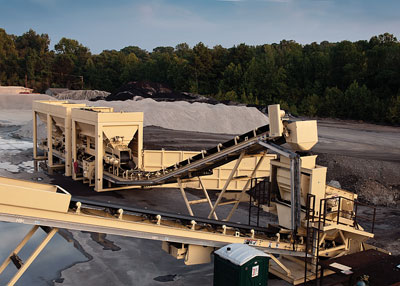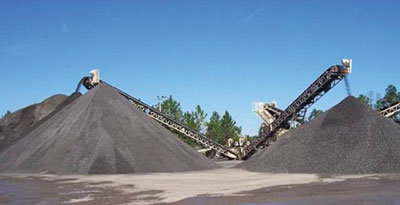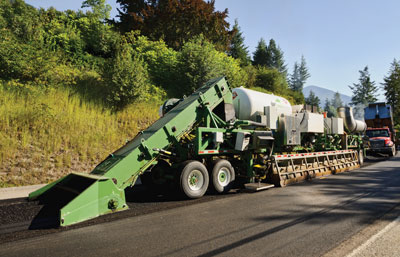
Features
Roads & Paving
Technology
State of RAP Industry I Where are we now?
A look at the evolution of asphalt recycling technologies and equipment.
August 10, 2012 By Treena Hein
The evolution of recycled asphalt has gone from simply using it as base,
to using single sizes back in the hot mix, to fractionating into
multiple sizes and treating it similarly to virgin aggregate, notes
Patrick Reaver.
The evolution of recycled asphalt has gone from simply using it as base, to using single sizes back in the hot mix, to fractionating into multiple sizes and treating it similarly to virgin aggregate, notes Patrick Reaver. “The largest difference in the amount able to be used directly correlates to treating the RAP (reclaimed asphalt pavement) more like a virgin mix form – how it is handled all the way to how it is processed,” says the product development manager at Astec Mobile Screens. Reaver believes the increasing demand for fractionated recycled asphalt paving products has led to their quality being equal to virgin products. This is a matter of both evolving equipment technologies as well as improved testing – to determine the age and quality of the asphalt cement as well as the quality of the aggregate and gradation of the RAP material.
 |
|
| Increasing demand for fractionated recycled asphalt paving products has led to their quality being equal to virgin products by companies such as Astec.
|
“Recycling of asphalt pavements has come a long way,” agrees Mike Rodriguez, district manager at Terex Roadbuilding. “It has accelerated in recent years, largely driven by the unstable price of petroleum and concern about the impact on the environment of carbon emissions.” Rodriguez believes most contractors across the country are using RAP if it’s specified in a contract – and to the greatest extent it’s allowed by the contract. (See next month’s issue for a detailed look at RAP use across Canada and beyond.) “The limitation on the use of RAP is not so much the contractor’s ability to produce mix designs containing RAP, but rather by the engineering decision on how much RAP is acceptable, if at all, for the particular application or job,” he says. It’s about control of quality and quantity of asphalt cement (AC) in the mix, he explains, and AC content in mix designs containing RAP is more difficult to control as the percentage of RAP increases.
Sandy Brown, technical director at the Ontario Hot Mix Producers Association (OHMPA), agrees that figuring out this issue is very important. “As a pavement ages on the ground over 20 to 25 years, the properties of the AC change chemically,” he says. Principally through oxidation, old pavement becomes stiffer and more subject to cracking at low temperature. The issue is more pronounced in the near surface (~15 mm) layers, but Brown notes that when the pavement is removed, processed and stockpiled prior to being recycled, the layers become mixed. “There has been much debate on the question of how much mixing occurs in the process of producing the new hot mix with RAP in a plant,” he notes. “In the past, it has been assumed that there is 100% mixing, but recent research has suggested that mixing, at least initially, is not 100%. This is undoubtedly correct in that the asphalt absorbed into the pores in the aggregates composing the RAP will likely never be available to mix with virgin asphalt added to new hot mix.” The OHMPA is funding research into this issue at the “Centre for Pavement and Technology Transfer” at the University of Waterloo, Ont.
Technological advances
Several key developments have allowed the use of RAP to expand. The first step in asphalt recycling is to remove RAP, crush/split it, and divide it into different sizes in order to correctly proportion the RAP to best match mix design gradation specifications. “The absolute best practice in this regard is to fractionate the RAP into the same number as the virgin aggregate is fractionated,” Rodriguez explains. “That is, if four bins (fractions) are used in the feeding of virgin materials for the plant, four bins should also be used in the RAP feeders to best allow for quality control, especially as the percentage of RAP increases.” However, he notes that many plants (especially portable ones) typically only operate a single or double RAP bin feeder based on ROI calculations.
 |
|
| Ground recycled asphalt stacked in a yard before being reused on the road.
|
Astec’s “FRAP” (fractionated RAP) process treats RAP very similarly to virgin product, says Reaver. “Typically, a customer looking to get involved in implementing FRAP needs an Impactor and a High Frequency Screen,” he explains. “The number of decks on the screen will change depending on how many products the customer wants to make, but the key is to remove the fines and coarse to minimize segregation,” Reaver notes.
Jorn Graugaard agrees that better fractionation makes more consistent asphalt quality, and also makes it much easier to control the amount of recycled material added. The general manager of paving and construction at Columbia Bitulithic (a division of Lafarge Canada Inc.) in Coquitlam, B.C., believes that more screening and prescreening advancements are coming. “Many more horizontal shaft impactors are being used than cones,” he adds, “which give better separation of oil and rock.”
After splitting/sizing, RAP is then injected into the mixing drum where it is combined with virgin aggregate. “This is an important step because not all asphalt plants are created equal in their ability to efficiently transfer heat energy into the RAP,” Rodriguez asserts. Kent Hansen, director of engineering at the U.S. National Asphalt Pavement Association (NAPA) notes that the biggest plant design change since RAP first began to be used in the 1970s has been from parallel-flow to counter-flow. Today, most are counter-flow, but Rodriguez says older counter-flow designs do not precondition the RAP (heat it up to virgin aggregate temperatures) before it is blended with the virgin aggregate and AC is added. “These plants require huge amounts of fuel to “super-heat” the virgin aggregate because of the process timing concept of the drum design,” he notes. “The RAP, wet and cold, is only added after the virgin materials leave the active heating portion of the drum, so any heat transferred to the RAP is parasitic to the heated virgin aggregate.” He says newer drum designs like that of the Terex E3 (launched in 2005) precondition the RAP by co-mingling the virgin aggregate and the RAP while still actively heating the mixture with the drum burner. Rodriguez notes that in many cases, this design also allows slightly reduced plant burner output.
A relatively new technique that has helped increase the usage of RAP is Warm Mix Asphalt (WMA), which was first introduced in 2005 and has rapidly become standard practice in many areas of North America. “WMA reduces the temperature at which asphalt pavements are produced and constructed,” Hansen explains. “[This] reduces the aging of the asphalt binder, making it likely that more RAP may be used in a mix before the asphalt binder grade is changed.” A NAPA survey found that WMA use in the U.S. increased from 19.2 to 47.6 million tons between 2009 and 2010.
One-pass recycling systems
One-pass Cold-In-Place (CIR) and Hot-In-Place (HIR) asphalt recycling trains are doing more and more paving on Canadian roads – increasing the use of RAP in the process. These techniques provide 20 to 30% cost savings compared to virgin paving, environmental impact benefits and obviously much-reduced traffic flow disruption. Except in cases of roads with light traffic flow, CIR requires that a new wearing course be applied over the recycled material. HIR uses heat to soften the surface layer of the pavement and treats the top five centimetres, while CIR uses no heat, but goes down another few centimetres.

|
|
| GreenRoads Recycling’s first prototype, the Super Preheater, is put to work on the road in Nelson, B.C.
|
Because of the size of the train and the logistics, CIR systems are not suited to urban environments, says Roadtec marketing manager Eric Baker. Roadtec has been marketing CIR equipment for about 20 years and has five units operating in Ontario. CIR is ideal, Baker says, where the road has surface cracks, but the structure is sound and the granular base is deep enough to provide a good platform. “If the existing road cannot support the traffic, then CIR will not fix it,” he says. “This is where Full Depth Reclamation (FDR) would be recommended.” FDR involves the full thickness of the asphalt pavement and a predetermined portion of the base, subbase and/or subgrade (four to 12 inches in all) to be uniformly pulverized and blended to provide an upgraded, homogeneous base material. Similarly to CIR, there is no addition of heat.
Roadtec’s RT-500 is a mobile recycle trailer that can either be fed and pulled by an RX-900 for CIR or set up on a site as a cold-mix plant. It has been on the market for about four years. “The advantage of the RT-500 is its closed loop sizing, thanks to the onboard vibratory screen and horizontal shaft impact crusher,” Baker says. “This also prevents you from having to pre-process your RAP when you use the RT-500 as a cold-mix plant. The RT-500 also has a weigh bridge on board to ensure extremely accurate additive injection in the pugmill.” This aspect was updated last year. While Terex does offer every piece contained within a CIR train, the company has no current plans to offer an integrated system, mostly due to uncertain market potential.
Norjohn Contracting and Paving Limited (a division of Walker Industries) of Niagara Falls, Ont., uses a Midland Mix Paver to create a new layer of 100% RAP base asphalt named Cold Recycled Mix (CRM). “It is a cost-effective way for municipalities anywhere in the province to use their RAP stockpiles to convert low-volume gravel roads into hard surfaces,” says sales and marketing manager Derek Nunn. “It is highly recommended that a chip seal be placed on top as the final riding surface.”
In the past, HIR mainly was used to resurface major highways, municipal roads and airports, but it is now being commonly used in cities as well, says Marina Kaplun, vice-president of business development and sales at Vancouver-based Martec Recycling. The company’s AR2000 Super Recycler is at work in many countries, but only one train is being used in Canada (in B.C.) at present. Kaplun points out that B.C. has shown leadership compared to other provinces in setting up an HIR program over 20 years ago, which has allowed one contractor to use the AR2000 ever since. Further Canadian sales for this relatively expensive system, says Kaplun, are being stymied because there is no assurance there will be enough HIR work. (See our next issue for details on what is happening with CIR and HIR in various jurisdictions.)
The AR2000 has a unique hot-air asphalt heating system. “Air is heated to 600 C in a diesel-fuelled combustion chamber and jets of this hot air are blown at high velocity onto the pavement through thousands of small holes in a heating plenum – to soften the existing materials for further hot milling without damaging the aggregates and burning the bitumen,” says Kaplun. “Because the hot air is vacuumed back for reheating, there is a significant saving for a contractor not only in material costs, but also in energy costs, along with benefits for the environment.”
Green Roads Recycling also has one HIR train at work in B.C. The automated control system and oxygen sensors under the heater box and temperature sensors at asphalt exit ensure no oxidation or over/under-heating of the asphalt, says general manager Shane Stothert. The control system ensures compliance with the mix design criteria during both steady and transient operations (fluctuating train speed or changing asphalt conditions). Reduction of the emissions from the heater incorporates a three-tiered approach.
It’s clear that as fuel prices, aggregate resource scarcity and environmental concerns grow, the use of RAP will continue to grow across the country. In expressing his opinion of the great value of RAP to the Canadian roadbuilding industry, Stothert sums up the views of many. “When I look at a road,” he says, “I see a ribbon of black gold.”
Print this page